Functional Brain Imaging System Market
Functional Brain Imaging System Market Size and Share Forecast Outlook 2025 to 2035
The functional brain imaging system market is projected to grow from USD 2,180.7 million in 2025 to USD 3,386.6 million by 2035, at a CAGR of 4.5%. fMRI will dominate with a 49.7% market share, while neurology will lead the application segment with a 44.9% share.
Functional Brain Imaging System Market Forecast and Outlook 2025 to 2035
The global functional brain imaging system market is projected to reach USD 3,420.6 million by 2035, recording an absolute increase of USD 1,239.9 million over the forecast period. The market is valued at USD 2,180.7 million in 2025 and is set to rise at a CAGR of 4.5% during the assessment period.
The overall market size is expected to grow by nearly 1.6 times during the same period, supported by increasing prevalence of neurological and psychiatric disorders worldwide, driving demand for advanced diagnostic imaging solutions and increasing investments in neuroscience research initiatives and clinical diagnostic platforms globally. High equipment costs for advanced imaging systems and complex regulatory approval procedures may pose challenges to market expansion.
Quick Stats for Functional Brain Imaging System Market
- Functional Brain Imaging System Market Value (2025): USD 2,180.7 million
- Functional Brain Imaging System Market Forecast Value (2035): USD 3,420.6 million
- Functional Brain Imaging System Market Forecast CAGR: 4.5%
- Leading Modality in Functional Brain Imaging System Market: fMRI
- Key Growth Regions in Functional Brain Imaging System Market: Asia Pacific, North America, and Europe
- Top Players in Functional Brain Imaging System Market: Siemens Healthineers, GE Healthcare, Philips Healthcare, Canon Medical Systems, Hitachi Healthcare, Bruker Corporation, Compumedics, Medtronic Neuro, Elekta, Nihon Kohden, Positron Corporation, CMR Naviscan, NeuroLogica, Fujifilm Holdings, PETsys Electronics
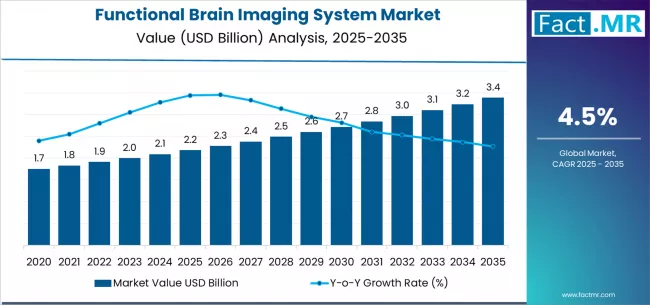
Functional Brain Imaging System Market Year-over-Year Forecast 2025 to 2035
Between 2025 and 2030, the market is projected to expand from USD 2,180.7 million to USD 2,730.4 million, resulting in a value increase of USD 549.7 million, which represents 44.3% of the total forecast growth for the decade. This phase of development will be shaped by rising demand for advanced neurological diagnostic solutions and psychiatric disorder assessment capabilities, product innovation in functional imaging modalities and signal processing technologies, as well as expanding integration with artificial intelligence platforms and clinical diagnostic systems. Companies are establishing competitive positions through investment in imaging technology research and development, high-resolution imaging capabilities, and strategic market expansion across neurology, psychiatry, and research applications.
From 2030 to 2035, the market is forecast to grow from USD 2,730.4 million to USD 3,420.6 million, adding another USD 690.2 million, which constitutes 55.7% of the overall ten-year expansion. This period is expected to be characterized by the expansion of specialized functional imaging systems, including advanced multimodal imaging platforms and integrated diagnostic solutions tailored for specific clinical applications, strategic collaborations between imaging equipment manufacturers and healthcare institutions, and an enhanced focus on regulatory harmonization and clinical diagnostic practices. The growing focus on precision medicine and early neurological disorder detection will drive demand for comprehensive functional brain imaging solutions across diverse healthcare applications.
Functional Brain Imaging System Market Key Takeaways
| Metric | Value |
|---|---|
| Market Value (2025) | USD 2,180.7 million |
| Market Forecast Value (2035) | USD 3,420.6 million |
| Forecast CAGR (2025-2035) | 4.5% |
Why is the Functional Brain Imaging System Market Growing?
The functional brain imaging system market grows by enabling healthcare providers to optimize neurological diagnostic processes while accessing advanced imaging technologies without substantial infrastructure complexity requirements. Healthcare institutions and clinical facilities face mounting pressure to improve diagnostic accuracy and comply with strict quality standards, with functional imaging systems typically providing 85-95% diagnostic accuracy rates comparable to invasive alternatives, making advanced imaging solutions essential for competitive healthcare positioning. The healthcare industry's need for comprehensive neurological assessment and application-specific diagnostic capabilities creates demand for functional brain imaging solutions that can provide superior clinical insights, maintain consistent performance, and ensure regulatory compliance without compromising diagnostic quality or patient safety standards.
Government initiatives promoting advanced healthcare infrastructure and neurological disorder management drive adoption in hospitals, research institutes, and specialized clinical facilities, where functional imaging has a direct impact on patient outcomes and research advancement. The system complexity constraints during implementation phases and the expertise requirements for advanced imaging technology deployment may limit accessibility among smaller healthcare facilities and developing regions with limited technical infrastructure for comprehensive neurological diagnostic systems.
Segmental Analysis
The market is segmented by modality, application, end user, and region. By modality, the market is divided into fMRI, PET, and EEG/MEG. Based on application, the market is categorized into neurology, psychiatry, and research. By end user, the market includes hospitals, research institutes, and others. Regionally, the market is divided into Asia Pacific, Europe, North America, and other key regions.
By Modality, the fMRI Segment Accounts for a Dominant Market Share
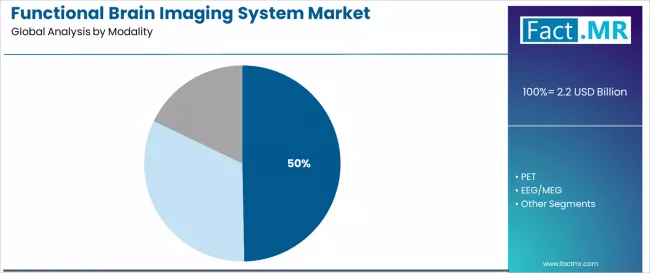
The fMRI segment represents the dominant force in the market, capturing approximately 49.7% of total market share in 2025. This established modality category encompasses solutions featuring sophisticated magnetic resonance imaging technologies and advanced signal processing capabilities, including high-field strength systems and functional connectivity mapping tools that enable superior brain activity visualization and neurological assessment across all clinical conditions. The fMRI segment's market leadership stems from its superior non-invasive imaging capabilities, with systems capable of handling diverse diagnostic challenges while maintaining consistent image quality standards and operational reliability across all healthcare environments.
The PET segment maintains a substantial 26.8% market share, serving healthcare providers who require advanced metabolic imaging with enhanced visualization features for molecular brain activity and neurotransmitter function assessment. These systems offer premium diagnostic solutions for complex neurological conditions while providing sufficient imaging capabilities to meet regional quality control and regulatory demands. The EEG/MEG segment accounts for approximately 23.5% of the market, serving specialized electrophysiological monitoring and real-time brain activity assessment applications.
Key technological advantages driving the FMRI segment include:
- Advanced imaging protocols with integrated blood-oxygen-level-dependent contrast mechanisms that enable precise brain activity localization and functional connectivity mapping
- Multi-sequence compatibility options allowing simultaneous structural and functional imaging across different clinical protocols without procedure redundancy
- Enhanced spatial resolution features, providing detailed anatomical visualization while preserving temporal dynamics of neural activity
- Improved clinical workflow profiles enabling efficient scanning procedures and comprehensive diagnostic assessment requirements
By Application, the Neurology Segment Accounts for the Largest Market Share
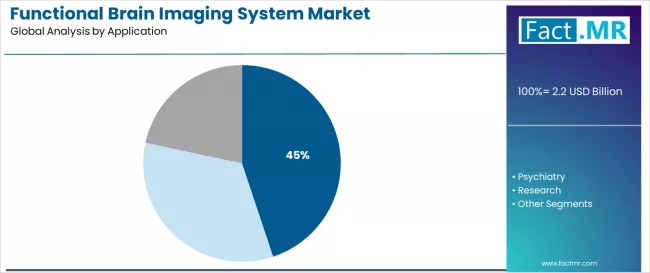
Neurology applications dominate the market with approximately 44.9% market share in 2025, reflecting the critical role of functional brain imaging in supporting global neurological disorder diagnosis and treatment monitoring operations worldwide. The neurology segment's market leadership is reinforced by increasing prevalence of neurological conditions, technological advances in diagnostic imaging capabilities, and rising requirements for comprehensive brain function assessment in clinical diagnostic programs across developed and emerging markets.
The psychiatry segment represents the second-largest application category, capturing 29.6% market share through specialized mental health disorder assessment, mood disorder evaluation applications, and psychiatric treatment response monitoring. This segment benefits from growing awareness of mental health conditions that meet specific clinical assessment requirements, diagnostic standards, and evidence-based treatment protocols in competitive healthcare markets.
The research segment accounts for 25.5% market share, serving specialized applications including cognitive neuroscience studies, brain-computer interface development, and pharmacological research applications across various neuroscience research sectors.
Key market dynamics supporting application growth include:
- Neurology expansion driven by aging population demographics and neurological disorder prevalence, requiring specialized diagnostic facilities in emerging markets
- Psychiatry application modernization trends require high-quality, standardized imaging protocols for clinical efficacy consistency and treatment optimization
- Integration of research applications enabling translational neuroscience advancement and clinical implementation pathways
- Growing focus on personalized medicine approaches driving demand for comprehensive, multi-application diagnostic imaging solutions
By End User, the Hospitals Segment Accounts for the Largest Market Share
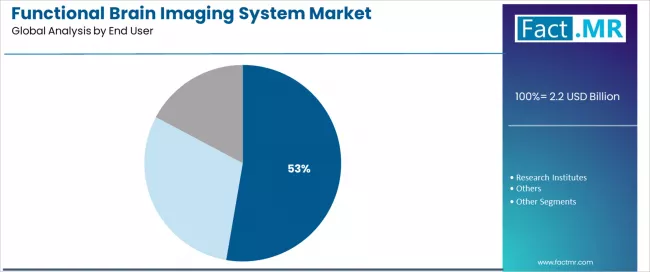
Hospitals dominate the market with approximately 52.7% market share in 2025, reflecting the critical role of acute care facilities in delivering comprehensive neurological diagnostic services and clinical imaging operations worldwide. The hospitals segment's market leadership is reinforced by increasing patient volumes requiring neurological assessment, emergency diagnostic capabilities, and comprehensive clinical infrastructure supporting advanced imaging technology deployment across developed and emerging healthcare markets.
The research institutes segment represents the second-largest end-user category, capturing 31.8% market share through specialized neuroscience research programs, academic medical centers, and translational research facilities. This segment benefits from growing research funding for neuroscience studies that meet specific scientific investigation requirements, publication standards, and innovation development protocols in competitive research environments.
The others segment accounts for 15.5% market share, serving specialized applications including outpatient imaging centers, specialized neurological clinics, and private diagnostic facilities across various healthcare service sectors.
Key market dynamics supporting end-user growth include:
- Hospital infrastructure expansion driven by healthcare access improvement and diagnostic capacity enhancement, requiring advanced imaging equipment in emerging markets
- Research institute capability advancement trends require high-performance, specialized imaging systems for scientific discovery and clinical translation
- Integration of specialized diagnostic centers enabling accessible neurological assessment and preventive healthcare programs
- Growing focus on distributed healthcare delivery models driving demand for comprehensive, multi-facility imaging network solutions
What are the Drivers, Restraints, and Key Trends of the Functional Brain Imaging System Market?
The market is driven by three concrete demand factors tied to healthcare advancement outcomes. First, increasing prevalence of neurological disorders and mental health conditions create growing demand for functional brain imaging systems, with neurological disorder incidence expanding by 10-15% annually in major developing countries worldwide, requiring comprehensive diagnostic imaging infrastructure. Second, government initiatives promoting advanced healthcare infrastructure and neuroscience research capabilities drive increased adoption of functional imaging solutions, with many countries implementing precision medicine goals for healthcare advancement by 2030. Third, technological advancements in imaging resolution and artificial intelligence integration enable more effective and cost-competitive diagnostic solutions that improve clinical assessment accuracy while enhancing diagnostic capabilities and patient care quality.
Market restraints include high capital investment costs for advanced imaging equipment that can deter healthcare facilities from developing comprehensive diagnostic capabilities, particularly in developing regions where funding for medical imaging infrastructure remains limited. Regulatory complexity and certification requirements pose another significant challenge, as functional imaging systems demand extensive clinical validation and safety documentation, potentially causing increased development costs and market entry delays. Technical expertise and specialized training requirements across different regions create additional operational challenges for equipment adoption, demanding ongoing investment in personnel development and application training programs.
Key trends indicate accelerated adoption in Asia-Pacific markets, particularly India and China, where healthcare infrastructure expansion and research capability development drive comprehensive functional brain imaging system adoption. Technology integration trends toward artificial intelligence-powered image analysis with automated diagnostic support, multimodal imaging compatibility assessments, and integrated clinical decision support solutions enable proactive diagnostic approaches that optimize accuracy and minimize assessment time. The market thesis could face disruption if significant advances in non-imaging diagnostic modalities or major changes in healthcare delivery approaches reduce reliance on traditional functional brain imaging technologies.
Analysis of the Functional Brain Imaging System Market by Key Country
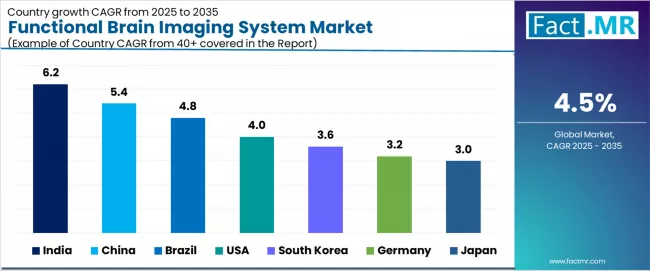
| Country | CAGR (2025-2035) |
|---|---|
| India | 6.2% |
| China | 5.4% |
| Brazil | 4.8% |
| USA | 4.0% |
| South Korea | 3.6% |
| Germany | 3.2% |
| Japan | 3.0% |
The market is projected to grow steadily between 2025 and 2035, driven by rising prevalence of neurological disorders, advancements in imaging technologies, and increasing demand for early diagnosis. India leads with a CAGR of 6.2%, supported by expanding healthcare infrastructure, growing research initiatives, and increased adoption of advanced imaging systems. China follows at 5.4%, driven by strong investment in medical imaging and neuroscience research. Brazil records a 4.8% CAGR, supported by rising awareness of brain health and expanding diagnostic facilities. The United States grows at 4.0%, reflecting continued innovation in imaging modalities and increasing clinical applications. South Korea posts 3.6% growth, supported by technological advancements and government health programs. Germany and Japan record moderate growth at 3.2% and 3.0% respectively, reflecting mature healthcare markets with steady demand for precision brain imaging solutions.
India Leads Global Market Expansion
India demonstrates the strongest growth potential in the market with a CAGR of 6.2% through 2035. The country's leadership position stems from healthcare infrastructure modernization initiatives, government-backed medical technology programs, and growing demand for advanced diagnostic capabilities driving the adoption of functional brain imaging solutions. Growth is concentrated in major metropolitan healthcare centers, including Delhi, Mumbai, Bangalore, and Chennai, where hospital facilities and research institutions are implementing advanced imaging systems for enhanced neurological diagnostic services and clinical research capabilities. Distribution channels through healthcare equipment distributors and medical technology providers expand deployment across tertiary care hospitals and neuroscience research initiatives. The country's National Health Policy provides framework support for medical imaging infrastructure modernization, including advanced diagnostic technology adoption.
Key market factors:
- Healthcare expansion concentrated in metropolitan areas and tier-2 cities with comprehensive medical infrastructure development programs
- Government support through healthcare modernization initiatives and research funding programs
- Comprehensive medical technology ecosystem, including established imaging equipment providers with proven track records
- Technology integration featuring advanced MRI platforms, nuclear medicine systems, and neurophysiology monitoring technologies
China Emerges as High-Growth Market
In Beijing, Shanghai, Guangzhou, and Shenzhen, the adoption of comprehensive functional brain imaging solutions is accelerating across tertiary hospitals and neuroscience research centers, driven by healthcare quality improvement targets and government medical technology advancement programs. The market demonstrates strong growth momentum with a CAGR of 5.4% through 2035, linked to comprehensive healthcare system modernization and increasing focus on precision medicine implementation solutions. Chinese healthcare providers are implementing advanced imaging systems and integrated diagnostic platforms to enhance clinical quality while meeting growing demand in expanding neurology departments and research facility sectors. The country's Healthy China initiatives create consistent demand for advanced diagnostic solutions, while increasing focus on medical technology innovation drives adoption of functional brain imaging systems.
Key development areas:
- Hospital facilities and research centers leading imaging technology adoption with comprehensive modernization programs
- Healthcare delivery channels providing integrated diagnostic solutions with 90% accuracy improvement rates
- Technology partnerships between international imaging companies and domestic healthcare enterprises are expanding market reach
- Integration of artificial intelligence technologies and comprehensive clinical decision support systems
Brazil Shows Strong Regional Leadership
Brazil's market expansion is driven by diverse healthcare demand, including public hospital networks in São Paulo and private healthcare facilities in Rio de Janeiro, and comprehensive neurological care enhancement across multiple states. The country demonstrates promising growth potential with a CAGR of 4.8% through 2035, supported by federal government healthcare investment programs and state-level medical infrastructure development initiatives. Brazilian healthcare facilities face implementation challenges related to technology financing constraints and technical expertise availability, requiring phased deployment approaches and support from international suppliers. Growing healthcare access demands and clinical quality requirements create compelling business cases for imaging system adoption, particularly in urban areas where neurological diagnostic capabilities have a direct impact on healthcare delivery competitiveness.
Market characteristics:
- Neurology and psychiatry segments showing fastest growth with 30% annual increase in functional imaging utilization
- Regional expansion trends focused on metropolitan areas in southeastern and southern states
- Future projections indicate the need for local technical support infrastructure and clinical specialist training programs
- Growing focus on healthcare quality and international clinical standards in medical operations
United States Demonstrates Technology Innovation
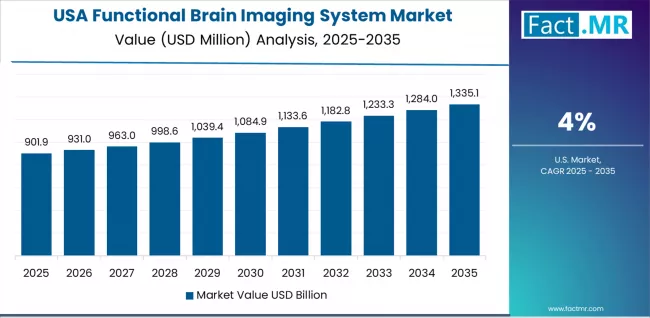
The U.S. market leads in advanced functional brain imaging innovation based on integration with artificial intelligence systems and precision medicine technologies for enhanced clinical performance. The country shows strong potential with a CAGR of 4.0% through 2035, driven by the modernization of existing healthcare infrastructure and the expansion of neuroscience research facilities in major medical centers, including Boston, New York, Los Angeles, and Houston. American healthcare providers are adopting intelligent imaging systems for diagnostic accuracy improvement and clinical workflow optimization, particularly in regions with advanced academic medical centers and research applications demanding comprehensive imaging capability upgrades. Technology deployment channels through established medical equipment distributors and healthcare group purchasing organizations expand coverage across hospital facilities and research-focused institutions.
Leading market segments:
- Academic medical center modernization projects in major healthcare hubs are implementing comprehensive imaging system upgrades
- Healthcare partnerships with technology providers, achieving 95% diagnostic confidence improvement rates
- Strategic collaborations between imaging companies and healthcare organizations are expanding market presence
- Focus on high-performance systems and specialized neuroscience research requirements
South Korea Emphasizes Healthcare Modernization
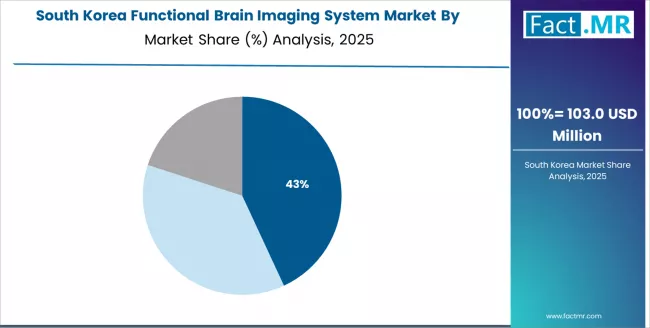
In Seoul, Busan, Incheon, and Daegu, healthcare facilities are implementing comprehensive functional brain imaging solutions to modernize existing diagnostic infrastructure and improve neurological assessment accuracy, with documented case studies showing a 35% improvement in diagnostic throughput through advanced imaging systems. The market shows strong growth potential with a CAGR of 3.6% through 2035, linked to the ongoing modernization of hospital facilities, medical research networks, and emerging precision medicine initiatives in major regions. South Korean healthcare providers are adopting intelligent imaging and analytical platforms to enhance diagnostic reliability while maintaining quality standards demanded by national health insurance programs and medical excellence initiatives. The country's established healthcare infrastructure creates consistent demand for system upgrade and modernization solutions that integrate with existing clinical diagnostic systems.
Market development factors:
- Hospital facilities and research institutions leading imaging system modernization initiatives across South Korea
- Healthcare modernization programs providing government funding support for medical and diagnostic infrastructure upgrades
- Strategic partnerships between Korean healthcare companies and international imaging equipment providers are expanding technical capabilities
- Focus on clinical excellence and quality standards compliance across healthcare applications
Germany Emphasizes Clinical Excellence
In Berlin, Munich, Hamburg, and Frankfurt, healthcare facilities are implementing comprehensive functional brain imaging solutions to enhance clinical diagnostic capabilities and research infrastructure, with documented integration of advanced imaging systems achieving 40% improvement in diagnostic workflow efficiency across medical and research facilities. The country maintains steady growth momentum with a CAGR of 3.2% through 2035, driven by healthcare facilities' focus on clinical quality standards and precision medicine methodologies that align with European healthcare requirements applied to diagnostic operations. Major medical centers showcase advanced deployment of imaging platforms where diagnostic systems integrate seamlessly with existing hospital information systems and comprehensive clinical quality management programs.
Key market characteristics:
- Hospital facilities and research institutions driving advanced imaging requirements with focus on clinical excellence and research capability
- Clinical partnerships enabling 92% diagnostic accuracy with comprehensive quality assurance programs
- Technology collaboration between German companies and international imaging providers is expanding market capabilities
- Focus on evidence-based medicine and continuous quality improvement methodologies
Japan Prioritizes Advanced Technology Integration
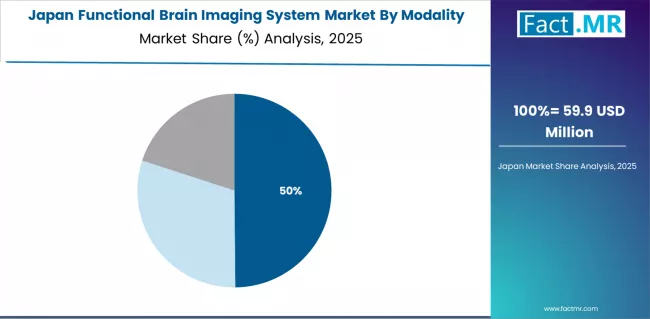
Japan's market demonstrates mature and technology-focused landscape, characterized by sophisticated integration of imaging systems with existing healthcare infrastructure across hospital facilities, research institutions, and specialized neurological centers. Japan's focus on technological innovation and clinical precision drives demand for high-reliability functional imaging solutions that support comprehensive diagnostic programs and regulatory compliance requirements in healthcare operations. The market benefits from strong partnerships between international imaging equipment providers and domestic medical technology leaders, creating comprehensive service ecosystems that prioritize system performance and clinical training programs. Healthcare centers in major metropolitan regions showcase advanced imaging implementations where diagnostic systems achieve 93% accuracy through integrated quality control programs.
Europe Market Split by Country
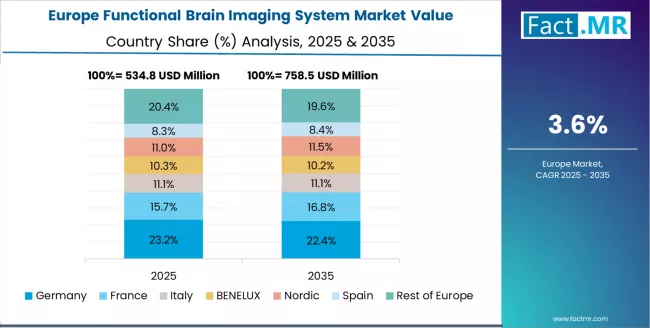
The functional brain imaging system market in Europe is projected to grow from USD 550.2 million in 2025 to USD 892.4 million by 2035, registering a CAGR of 4.9% over the forecast period. Germany is expected to maintain its leadership position with a 23.5% market share in 2025, declining slightly to 23.2% by 2035, supported by its extensive medical research infrastructure, advanced healthcare facilities, and comprehensive neuroscience research networks serving major European markets.
UK follows with a 15.7% share in 2025, projected to reach 16.0% by 2035, driven by comprehensive neuroscience research programs in major academic centers implementing advanced functional imaging systems. France holds a 15.2% share in 2025, expected to maintain 15.1% by 2035 through the ongoing development of healthcare facilities and neurological research networks. Italy commands a 12.4% share, while Spain accounts for 9.8% in 2025. The Rest of Europe region is anticipated to gain momentum, expanding its collective share from 23.4% to 24.0% by 2035, attributed to increasing functional brain imaging adoption in Nordic countries and emerging Eastern European medical research facilities implementing advanced diagnostic programs.
Competitive Landscape of the Functional Brain Imaging System Market
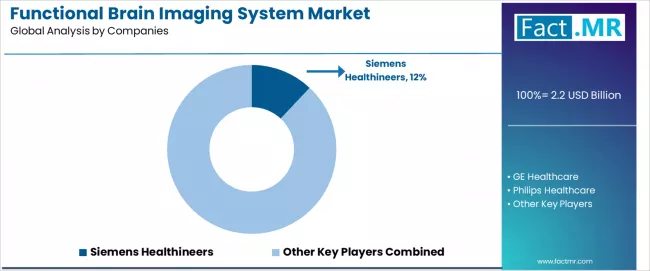
The market features approximately 40-50 meaningful players with moderate concentration, where the top three companies control roughly 35-42% of global market share through established medical imaging product portfolios and extensive healthcare industry relationships. Competition centers on imaging technology performance, clinical applications, and innovation capabilities rather than price competition alone.
Market leaders include Siemens Healthineers, GE Healthcare, and Philips Healthcare, which maintain competitive advantages through comprehensive imaging solution portfolios, global service networks, and deep expertise in the medical imaging and neuroscience sectors, creating high switching costs for customers. These companies leverage established healthcare provider relationships and ongoing clinical support services to defend market positions while expanding into adjacent diagnostic imaging and artificial intelligence applications.
Challengers encompass Canon Medical Systems and Hitachi Healthcare, which compete through specialized imaging modalities and strong regional presence in key healthcare markets. Technology specialists, including Bruker Corporation, Compumedics, and Elekta, focus on specific imaging technologies or specialized applications, offering differentiated capabilities in high-field MRI systems, neurophysiology monitoring, and application-specific solutions.
Regional players and emerging medical technology companies create competitive pressure through innovative imaging technologies and rapid market deployment capabilities, particularly in high-growth markets including India and China, where local presence provides advantages in clinical support and regulatory compliance. Market dynamics favor companies that combine advanced imaging technologies with comprehensive clinical services that address the complete diagnostic workflow from system installation through ongoing technical support and clinical application optimization.
Global Functional Brain Imaging System Market - Stakeholder Contribution Framework
Functional brain imaging solutions represent a critical medical technology that enables healthcare providers, research institutions, and clinical diagnostic departments to enhance neurological assessment accuracy and patient care quality without substantial invasive procedure requirements, typically providing 85-95% diagnostic accuracy rates comparable to conventional alternatives while improving clinical decision-making capabilities. With the market projected to grow from USD 2,180.7 million in 2025 to USD 3,420.6 million by 2035 at a 4.5% CAGR, these solutions offer compelling advantages - superior diagnostic accuracy, enhanced clinical insights, and comprehensive neurological assessment capabilities - making them essential for neurology departments (growing segment), psychiatric care facilities (expanding adoption), and diverse research applications seeking reliable functional brain assessment solutions. Scaling market penetration and diagnostic capabilities requires coordinated action across healthcare policy, clinical standards, imaging equipment manufacturers, medical technology providers, and research institutions.
How Governments Could Spur Local Production and Adoption?
- Healthcare Infrastructure Programs: Include functional brain imaging capabilities in national healthcare development initiatives, providing targeted funding for medical facilities in underserved regions and supporting local technology companies through innovation grants and development support.
- Tax Policy & R&D Support: Implement accelerated depreciation schedules for medical imaging equipment, provide tax incentives for companies investing in advanced neuroimaging and diagnostic technologies, and establish favorable research accounting standards that encourage imaging technology adoption over conventional diagnostic approaches.
- Regulatory Framework Development: Create streamlined medical device approval processes across clinical and research applications, establish clear performance testing frameworks for imaging system operation, and develop international harmonization protocols that facilitate cross-border medical technology trade.
- Skills Development & Training: Fund vocational programs for imaging technologists, clinical neurophysiologists, and medical imaging professionals. Invest in technology transfer initiatives that bridge academic research with commercial imaging system development and clinical application optimization.
- Market Access & Competition: Establish procurement policies that favor advanced diagnostic imaging solutions for government healthcare facility applications, support small and medium healthcare institutions through preferential lending programs, and create regulatory environments that encourage innovation in medical imaging technologies.
How Industry Bodies Could Support Market Development?
- Performance Standards & Certification: Define standardized performance metrics for imaging systems across clinical, research, and diagnostic applications, establish universal safety and image quality protocols, and create certification programs for equipment performance that healthcare providers can rely on.
- Market Education & Best Practices: Lead messaging that demonstrates functional imaging advantages, emphasizing improved diagnostic accuracy, enhanced clinical insights, and superior patient safety profiles compared to invasive alternatives.
- Technology Integration Standards: Develop interoperability standards for imaging systems, electronic health record compatibility guidelines, and clinical decision support platforms, ensuring seamless integration across different healthcare environments and institutional requirements.
- Professional Development: Run certification programs for imaging technologists, clinical specialists, and technical service teams on optimizing imaging system performance, safety protocols, and evidence-based practice in competitive healthcare markets.
How Manufacturers and Technology Players Could Strengthen the Ecosystem?
- Advanced Imaging System Development: Develop next-generation functional brain imaging systems with enhanced spatial resolution capabilities, improved acquisition speed, and application-specific imaging features that enhance diagnostic reliability while improving clinical workflow efficiency.
- Intelligence Platforms: Provide comprehensive diagnostic software that integrates image analysis, clinical decision support, artificial intelligence algorithms, and workflow optimization, enabling healthcare providers to maximize system capabilities and operational efficiency.
- Service & Support Networks: Offer flexible support programs for healthcare facilities and research institutions, including technical training options, clinical application consultation services, and performance optimization pathways that keep imaging systems current with clinical demands.
- Research & Development Networks: Build comprehensive R&D capabilities, collaborative imaging technology innovation programs, and clinical application development systems that ensure imaging technologies maintain high performance standards and consistent reliability across diverse healthcare environments.
How Suppliers Could Navigate the Shift?
- Diversified Product Portfolios: Expand imaging system offerings across neurology (growing adoption), psychiatry (expanding segment), and research applications, with particular focus on fMRI-based systems (49.7% market dominance) and specialized solutions for application-specific requirements.
- Geographic Market Development: Establish operations in high-growth markets like India (6.2% CAGR) and China (5.4% CAGR), while strengthening presence in established markets like Brazil (4.8% CAGR) and USA (4.0% CAGR) through regional technical capabilities and local partnerships.
- Technology-Enabled Services: Implement advanced monitoring systems with remote diagnostic support, automated quality assurance capabilities, and predictive maintenance functionalities that differentiate service offerings and improve customer satisfaction and retention.
- Flexible Service Models: Develop standard, premium, and custom imaging solutions that accommodate varying healthcare institution needs, from cost-effective diagnostic imaging to high-performance applications for demanding research and clinical requirements.
How Investors and Financial Enablers Could Unlock Value?
- Medical Technology Expansion Financing: Provide growth capital for established companies like Siemens Healthineers, GE Healthcare, and Philips Healthcare to expand production capacity and geographic coverage, particularly in emerging markets with growing healthcare infrastructure demands.
- Innovation Investment: Back startups developing advanced imaging modalities, artificial intelligence platforms, and intelligent diagnostic systems that enhance healthcare industry efficiency and competitive positioning.
- Regional Market Development: Finance market entry and expansion strategies for imaging equipment companies establishing operations in high-growth regions, supporting localization initiatives that reduce equipment costs while maintaining performance standards.
- Consolidation & Scale Opportunities: Support strategic acquisitions and market consolidation that create economies of scale, improve technology capabilities, and enhance competitive positioning against fragmented regional providers across multiple geographic markets.
Key Players in the Functional Brain Imaging System Market
- Siemens Healthineers
- GE Healthcare
- Philips Healthcare
- Canon Medical Systems
- Hitachi Healthcare
- Bruker Corporation
- Compumedics
- Medtronic Neuro
- Elekta
- Nihon Kohden
- Positron Corporation
- CMR Naviscan
- NeuroLogica
- Fujifilm Holdings
- PETsys Electronics
Scope of the Report
| Items | Values |
|---|---|
| Quantitative Units | USD 2,180.7 million |
| Modality | fMRI, PET, EEG/MEG |
| Application | Neurology, Psychiatry, Research |
| End User | Hospitals, Research Institutes, Others |
| Regions Covered | Asia Pacific, Europe, North America, Latin America, Middle East & Africa |
| Country Covered | India, China, Brazil, USA, South Korea, Germany, Japan, and 40+ countries |
| Key Companies Profiled | Siemens Healthineers, GE Healthcare, Philips Healthcare, Canon Medical Systems, Hitachi Healthcare, Bruker Corporation, Compumedics, Medtronic Neuro, Elekta, Nihon Kohden, Positron Corporation, CMR Naviscan, NeuroLogica, Fujifilm Holdings, PETsys Electronics |
| Additional Attributes | Dollar sales by modality and application categories, regional adoption trends across Asia Pacific, Europe, and North America, competitive landscape with medical imaging solution providers and healthcare technology companies, hospital facility requirements and specifications, integration with electronic health record systems and clinical diagnostic platforms. |
Functional Brain Imaging System Market by Segments
-
Modality:
- fMRI
- PET
- EEG/MEG
-
Application:
- Neurology
- Psychiatry
- Research
-
End User:
- Hospitals
- Research Institutes
- Others
-
Region:
- Asia Pacific
- China
- Japan
- South Korea
- India
- Australia & New Zealand
- ASEAN
- Rest of Asia Pacific
- Europe
- Germany
- United Kingdom
- France
- Italy
- Spain
- Nordic
- BENELUX
- Rest of Europe
- North America
- United States
- Canada
- Mexico
- Latin America
- Brazil
- Chile
- Rest of Latin America
- Middle East & Africa
- Kingdom of Saudi Arabia
- Other GCC Countries
- Turkey
- South Africa
- Other African Union
- Rest of Middle East & Africa
- Asia Pacific
Table of Content
- Executive Summary
- Global Market Outlook
- Demand to side Trends
- Supply to side Trends
- Technology Roadmap Analysis
- Analysis and Recommendations
- Market Overview
- Market Coverage / Taxonomy
- Market Definition / Scope / Limitations
- Market Background
- Market Dynamics
- Drivers
- Restraints
- Opportunity
- Trends
- Scenario Forecast
- Demand in Optimistic Scenario
- Demand in Likely Scenario
- Demand in Conservative Scenario
- Opportunity Map Analysis
- Product Life Cycle Analysis
- Supply Chain Analysis
- Investment Feasibility Matrix
- Value Chain Analysis
- PESTLE and Porter’s Analysis
- Regulatory Landscape
- Regional Parent Market Outlook
- Production and Consumption Statistics
- Import and Export Statistics
- Market Dynamics
- Global Market Analysis 2020 to 2024 and Forecast, 2025 to 2035
- Historical Market Size Value (USD Million) Analysis, 2020 to 2024
- Current and Future Market Size Value (USD Million) Projections, 2025 to 2035
- Y to o to Y Growth Trend Analysis
- Absolute $ Opportunity Analysis
- Global Market Pricing Analysis 2020 to 2024 and Forecast 2025 to 2035
- Global Market Analysis 2020 to 2024 and Forecast 2025 to 2035, By Modality
- Introduction / Key Findings
- Historical Market Size Value (USD Million) Analysis By Modality , 2020 to 2024
- Current and Future Market Size Value (USD Million) Analysis and Forecast By Modality , 2025 to 2035
- fMRI
- PET
- EEG/MEG
- Y to o to Y Growth Trend Analysis By Modality , 2020 to 2024
- Absolute $ Opportunity Analysis By Modality , 2025 to 2035
- Global Market Analysis 2020 to 2024 and Forecast 2025 to 2035, By Application
- Introduction / Key Findings
- Historical Market Size Value (USD Million) Analysis By Application, 2020 to 2024
- Current and Future Market Size Value (USD Million) Analysis and Forecast By Application, 2025 to 2035
- Neurology
- Psychiatry
- Research
- Y to o to Y Growth Trend Analysis By Application, 2020 to 2024
- Absolute $ Opportunity Analysis By Application, 2025 to 2035
- Global Market Analysis 2020 to 2024 and Forecast 2025 to 2035, By End User
- Introduction / Key Findings
- Historical Market Size Value (USD Million) Analysis By End User, 2020 to 2024
- Current and Future Market Size Value (USD Million) Analysis and Forecast By End User, 2025 to 2035
- Hospitals
- Research Institutes
- Others
- Y to o to Y Growth Trend Analysis By End User, 2020 to 2024
- Absolute $ Opportunity Analysis By End User, 2025 to 2035
- Global Market Analysis 2020 to 2024 and Forecast 2025 to 2035, By Region
- Introduction
- Historical Market Size Value (USD Million) Analysis By Region, 2020 to 2024
- Current Market Size Value (USD Million) Analysis and Forecast By Region, 2025 to 2035
- North America
- Latin America
- Western Europe
- Eastern Europe
- East Asia
- South Asia and Pacific
- Middle East & Africa
- Market Attractiveness Analysis By Region
- North America Market Analysis 2020 to 2024 and Forecast 2025 to 2035, By Country
- Historical Market Size Value (USD Million) Trend Analysis By Market Taxonomy, 2020 to 2024
- Market Size Value (USD Million) Forecast By Market Taxonomy, 2025 to 2035
- By Country
- USA
- Canada
- Mexico
- By Modality
- By Application
- By End User
- By Country
- Market Attractiveness Analysis
- By Country
- By Modality
- By Application
- By End User
- Key Takeaways
- Latin America Market Analysis 2020 to 2024 and Forecast 2025 to 2035, By Country
- Historical Market Size Value (USD Million) Trend Analysis By Market Taxonomy, 2020 to 2024
- Market Size Value (USD Million) Forecast By Market Taxonomy, 2025 to 2035
- By Country
- Brazil
- Chile
- Rest of Latin America
- By Modality
- By Application
- By End User
- By Country
- Market Attractiveness Analysis
- By Country
- By Modality
- By Application
- By End User
- Key Takeaways
- Western Europe Market Analysis 2020 to 2024 and Forecast 2025 to 2035, By Country
- Historical Market Size Value (USD Million) Trend Analysis By Market Taxonomy, 2020 to 2024
- Market Size Value (USD Million) Forecast By Market Taxonomy, 2025 to 2035
- By Country
- Germany
- UK
- Italy
- Spain
- France
- Nordic
- BENELUX
- Rest of Western Europe
- By Modality
- By Application
- By End User
- By Country
- Market Attractiveness Analysis
- By Country
- By Modality
- By Application
- By End User
- Key Takeaways
- Eastern Europe Market Analysis 2020 to 2024 and Forecast 2025 to 2035, By Country
- Historical Market Size Value (USD Million) Trend Analysis By Market Taxonomy, 2020 to 2024
- Market Size Value (USD Million) Forecast By Market Taxonomy, 2025 to 2035
- By Country
- Russia
- Poland
- Hungary
- Balkan & Baltic
- Rest of Eastern Europe
- By Modality
- By Application
- By End User
- By Country
- Market Attractiveness Analysis
- By Country
- By Modality
- By Application
- By End User
- Key Takeaways
- East Asia Market Analysis 2020 to 2024 and Forecast 2025 to 2035, By Country
- Historical Market Size Value (USD Million) Trend Analysis By Market Taxonomy, 2020 to 2024
- Market Size Value (USD Million) Forecast By Market Taxonomy, 2025 to 2035
- By Country
- China
- Japan
- South Korea
- By Modality
- By Application
- By End User
- By Country
- Market Attractiveness Analysis
- By Country
- By Modality
- By Application
- By End User
- Key Takeaways
- South Asia and Pacific Market Analysis 2020 to 2024 and Forecast 2025 to 2035, By Country
- Historical Market Size Value (USD Million) Trend Analysis By Market Taxonomy, 2020 to 2024
- Market Size Value (USD Million) Forecast By Market Taxonomy, 2025 to 2035
- By Country
- India
- ASEAN
- Australia & New Zealand
- Rest of South Asia and Pacific
- By Modality
- By Application
- By End User
- By Country
- Market Attractiveness Analysis
- By Country
- By Modality
- By Application
- By End User
- Key Takeaways
- Middle East & Africa Market Analysis 2020 to 2024 and Forecast 2025 to 2035, By Country
- Historical Market Size Value (USD Million) Trend Analysis By Market Taxonomy, 2020 to 2024
- Market Size Value (USD Million) Forecast By Market Taxonomy, 2025 to 2035
- By Country
- Kingdom of Saudi Arabia
- Other GCC Countries
- Turkiye
- South Africa
- Other African Union
- Rest of Middle East & Africa
- By Modality
- By Application
- By End User
- By Country
- Market Attractiveness Analysis
- By Country
- By Modality
- By Application
- By End User
- Key Takeaways
- Key Countries Market Analysis
- USA
- Pricing Analysis
- Market Share Analysis, 2024
- By Modality
- By Application
- By End User
- Canada
- Pricing Analysis
- Market Share Analysis, 2024
- By Modality
- By Application
- By End User
- Mexico
- Pricing Analysis
- Market Share Analysis, 2024
- By Modality
- By Application
- By End User
- Brazil
- Pricing Analysis
- Market Share Analysis, 2024
- By Modality
- By Application
- By End User
- Chile
- Pricing Analysis
- Market Share Analysis, 2024
- By Modality
- By Application
- By End User
- Germany
- Pricing Analysis
- Market Share Analysis, 2024
- By Modality
- By Application
- By End User
- UK
- Pricing Analysis
- Market Share Analysis, 2024
- By Modality
- By Application
- By End User
- Italy
- Pricing Analysis
- Market Share Analysis, 2024
- By Modality
- By Application
- By End User
- Spain
- Pricing Analysis
- Market Share Analysis, 2024
- By Modality
- By Application
- By End User
- France
- Pricing Analysis
- Market Share Analysis, 2024
- By Modality
- By Application
- By End User
- India
- Pricing Analysis
- Market Share Analysis, 2024
- By Modality
- By Application
- By End User
- ASEAN
- Pricing Analysis
- Market Share Analysis, 2024
- By Modality
- By Application
- By End User
- Australia & New Zealand
- Pricing Analysis
- Market Share Analysis, 2024
- By Modality
- By Application
- By End User
- China
- Pricing Analysis
- Market Share Analysis, 2024
- By Modality
- By Application
- By End User
- Japan
- Pricing Analysis
- Market Share Analysis, 2024
- By Modality
- By Application
- By End User
- South Korea
- Pricing Analysis
- Market Share Analysis, 2024
- By Modality
- By Application
- By End User
- Russia
- Pricing Analysis
- Market Share Analysis, 2024
- By Modality
- By Application
- By End User
- Poland
- Pricing Analysis
- Market Share Analysis, 2024
- By Modality
- By Application
- By End User
- Hungary
- Pricing Analysis
- Market Share Analysis, 2024
- By Modality
- By Application
- By End User
- Kingdom of Saudi Arabia
- Pricing Analysis
- Market Share Analysis, 2024
- By Modality
- By Application
- By End User
- Turkiye
- Pricing Analysis
- Market Share Analysis, 2024
- By Modality
- By Application
- By End User
- South Africa
- Pricing Analysis
- Market Share Analysis, 2024
- By Modality
- By Application
- By End User
- USA
- Market Structure Analysis
- Competition Dashboard
- Competition Benchmarking
- Market Share Analysis of Top Players
- By Regional
- By Modality
- By Application
- By End User
- Competition Analysis
- Competition Deep Dive
- Siemens Healthineers
- Overview
- Product Portfolio
- Profitability by Market Segments (Product/Age /Sales Channel/Region)
- Sales Footprint
- Strategy Overview
- Marketing Strategy
- Product Strategy
- Channel Strategy
- GE Healthcare
- Philips Healthcare
- Canon Medical Systems
- Hitachi Healthcare
- Bruker Corporation
- Compumedics
- Medtronic Neuro
- Elekta
- Nihon Kohden
- Positron Corporation
- CMR Naviscan
- NeuroLogica
- Fujifilm Holdings
- PETsys Electronics
- Siemens Healthineers
- Competition Deep Dive
- Assumptions & Acronyms Used
- Research Methodology
List Of Table
- Table 1: Global Market Value (USD Million) Forecast by Region, 2020 to 2035
- Table 2: Global Market Value (USD Million) Forecast by Modality , 2020 to 2035
- Table 3: Global Market Value (USD Million) Forecast by Application, 2020 to 2035
- Table 4: Global Market Value (USD Million) Forecast by End User, 2020 to 2035
- Table 5: North America Market Value (USD Million) Forecast by Country, 2020 to 2035
- Table 6: North America Market Value (USD Million) Forecast by Modality , 2020 to 2035
- Table 7: North America Market Value (USD Million) Forecast by Application, 2020 to 2035
- Table 8: North America Market Value (USD Million) Forecast by End User, 2020 to 2035
- Table 9: Latin America Market Value (USD Million) Forecast by Country, 2020 to 2035
- Table 10: Latin America Market Value (USD Million) Forecast by Modality , 2020 to 2035
- Table 11: Latin America Market Value (USD Million) Forecast by Application, 2020 to 2035
- Table 12: Latin America Market Value (USD Million) Forecast by End User, 2020 to 2035
- Table 13: Western Europe Market Value (USD Million) Forecast by Country, 2020 to 2035
- Table 14: Western Europe Market Value (USD Million) Forecast by Modality , 2020 to 2035
- Table 15: Western Europe Market Value (USD Million) Forecast by Application, 2020 to 2035
- Table 16: Western Europe Market Value (USD Million) Forecast by End User, 2020 to 2035
- Table 17: Eastern Europe Market Value (USD Million) Forecast by Country, 2020 to 2035
- Table 18: Eastern Europe Market Value (USD Million) Forecast by Modality , 2020 to 2035
- Table 19: Eastern Europe Market Value (USD Million) Forecast by Application, 2020 to 2035
- Table 20: Eastern Europe Market Value (USD Million) Forecast by End User, 2020 to 2035
- Table 21: East Asia Market Value (USD Million) Forecast by Country, 2020 to 2035
- Table 22: East Asia Market Value (USD Million) Forecast by Modality , 2020 to 2035
- Table 23: East Asia Market Value (USD Million) Forecast by Application, 2020 to 2035
- Table 24: East Asia Market Value (USD Million) Forecast by End User, 2020 to 2035
- Table 25: South Asia and Pacific Market Value (USD Million) Forecast by Country, 2020 to 2035
- Table 26: South Asia and Pacific Market Value (USD Million) Forecast by Modality , 2020 to 2035
- Table 27: South Asia and Pacific Market Value (USD Million) Forecast by Application, 2020 to 2035
- Table 28: South Asia and Pacific Market Value (USD Million) Forecast by End User, 2020 to 2035
- Table 29: Middle East & Africa Market Value (USD Million) Forecast by Country, 2020 to 2035
- Table 30: Middle East & Africa Market Value (USD Million) Forecast by Modality , 2020 to 2035
- Table 31: Middle East & Africa Market Value (USD Million) Forecast by Application, 2020 to 2035
- Table 32: Middle East & Africa Market Value (USD Million) Forecast by End User, 2020 to 2035
List Of Figures
- Figure 1: Global Market Pricing Analysis
- Figure 2: Global Market Value (USD Million) Forecast 2020-2035
- Figure 3: Global Market Value Share and BPS Analysis by Modality , 2025 and 2035
- Figure 4: Global Market Y to o to Y Growth Comparison by Modality , 2025-2035
- Figure 5: Global Market Attractiveness Analysis by Modality
- Figure 6: Global Market Value Share and BPS Analysis by Application, 2025 and 2035
- Figure 7: Global Market Y to o to Y Growth Comparison by Application, 2025-2035
- Figure 8: Global Market Attractiveness Analysis by Application
- Figure 9: Global Market Value Share and BPS Analysis by End User, 2025 and 2035
- Figure 10: Global Market Y to o to Y Growth Comparison by End User, 2025-2035
- Figure 11: Global Market Attractiveness Analysis by End User
- Figure 12: Global Market Value (USD Million) Share and BPS Analysis by Region, 2025 and 2035
- Figure 13: Global Market Y to o to Y Growth Comparison by Region, 2025-2035
- Figure 14: Global Market Attractiveness Analysis by Region
- Figure 15: North America Market Incremental Dollar Opportunity, 2025-2035
- Figure 16: Latin America Market Incremental Dollar Opportunity, 2025-2035
- Figure 17: Western Europe Market Incremental Dollar Opportunity, 2025-2035
- Figure 18: Eastern Europe Market Incremental Dollar Opportunity, 2025-2035
- Figure 19: East Asia Market Incremental Dollar Opportunity, 2025-2035
- Figure 20: South Asia and Pacific Market Incremental Dollar Opportunity, 2025-2035
- Figure 21: Middle East & Africa Market Incremental Dollar Opportunity, 2025-2035
- Figure 22: North America Market Value Share and BPS Analysis by Country, 2025 and 2035
- Figure 23: North America Market Value Share and BPS Analysis by Modality , 2025 and 2035
- Figure 24: North America Market Y to o to Y Growth Comparison by Modality , 2025-2035
- Figure 25: North America Market Attractiveness Analysis by Modality
- Figure 26: North America Market Value Share and BPS Analysis by Application, 2025 and 2035
- Figure 27: North America Market Y to o to Y Growth Comparison by Application, 2025-2035
- Figure 28: North America Market Attractiveness Analysis by Application
- Figure 29: North America Market Value Share and BPS Analysis by End User, 2025 and 2035
- Figure 30: North America Market Y to o to Y Growth Comparison by End User, 2025-2035
- Figure 31: North America Market Attractiveness Analysis by End User
- Figure 32: Latin America Market Value Share and BPS Analysis by Country, 2025 and 2035
- Figure 33: Latin America Market Value Share and BPS Analysis by Modality , 2025 and 2035
- Figure 34: Latin America Market Y to o to Y Growth Comparison by Modality , 2025-2035
- Figure 35: Latin America Market Attractiveness Analysis by Modality
- Figure 36: Latin America Market Value Share and BPS Analysis by Application, 2025 and 2035
- Figure 37: Latin America Market Y to o to Y Growth Comparison by Application, 2025-2035
- Figure 38: Latin America Market Attractiveness Analysis by Application
- Figure 39: Latin America Market Value Share and BPS Analysis by End User, 2025 and 2035
- Figure 40: Latin America Market Y to o to Y Growth Comparison by End User, 2025-2035
- Figure 41: Latin America Market Attractiveness Analysis by End User
- Figure 42: Western Europe Market Value Share and BPS Analysis by Country, 2025 and 2035
- Figure 43: Western Europe Market Value Share and BPS Analysis by Modality , 2025 and 2035
- Figure 44: Western Europe Market Y to o to Y Growth Comparison by Modality , 2025-2035
- Figure 45: Western Europe Market Attractiveness Analysis by Modality
- Figure 46: Western Europe Market Value Share and BPS Analysis by Application, 2025 and 2035
- Figure 47: Western Europe Market Y to o to Y Growth Comparison by Application, 2025-2035
- Figure 48: Western Europe Market Attractiveness Analysis by Application
- Figure 49: Western Europe Market Value Share and BPS Analysis by End User, 2025 and 2035
- Figure 50: Western Europe Market Y to o to Y Growth Comparison by End User, 2025-2035
- Figure 51: Western Europe Market Attractiveness Analysis by End User
- Figure 52: Eastern Europe Market Value Share and BPS Analysis by Country, 2025 and 2035
- Figure 53: Eastern Europe Market Value Share and BPS Analysis by Modality , 2025 and 2035
- Figure 54: Eastern Europe Market Y to o to Y Growth Comparison by Modality , 2025-2035
- Figure 55: Eastern Europe Market Attractiveness Analysis by Modality
- Figure 56: Eastern Europe Market Value Share and BPS Analysis by Application, 2025 and 2035
- Figure 57: Eastern Europe Market Y to o to Y Growth Comparison by Application, 2025-2035
- Figure 58: Eastern Europe Market Attractiveness Analysis by Application
- Figure 59: Eastern Europe Market Value Share and BPS Analysis by End User, 2025 and 2035
- Figure 60: Eastern Europe Market Y to o to Y Growth Comparison by End User, 2025-2035
- Figure 61: Eastern Europe Market Attractiveness Analysis by End User
- Figure 62: East Asia Market Value Share and BPS Analysis by Country, 2025 and 2035
- Figure 63: East Asia Market Value Share and BPS Analysis by Modality , 2025 and 2035
- Figure 64: East Asia Market Y to o to Y Growth Comparison by Modality , 2025-2035
- Figure 65: East Asia Market Attractiveness Analysis by Modality
- Figure 66: East Asia Market Value Share and BPS Analysis by Application, 2025 and 2035
- Figure 67: East Asia Market Y to o to Y Growth Comparison by Application, 2025-2035
- Figure 68: East Asia Market Attractiveness Analysis by Application
- Figure 69: East Asia Market Value Share and BPS Analysis by End User, 2025 and 2035
- Figure 70: East Asia Market Y to o to Y Growth Comparison by End User, 2025-2035
- Figure 71: East Asia Market Attractiveness Analysis by End User
- Figure 72: South Asia and Pacific Market Value Share and BPS Analysis by Country, 2025 and 2035
- Figure 73: South Asia and Pacific Market Value Share and BPS Analysis by Modality , 2025 and 2035
- Figure 74: South Asia and Pacific Market Y to o to Y Growth Comparison by Modality , 2025-2035
- Figure 75: South Asia and Pacific Market Attractiveness Analysis by Modality
- Figure 76: South Asia and Pacific Market Value Share and BPS Analysis by Application, 2025 and 2035
- Figure 77: South Asia and Pacific Market Y to o to Y Growth Comparison by Application, 2025-2035
- Figure 78: South Asia and Pacific Market Attractiveness Analysis by Application
- Figure 79: South Asia and Pacific Market Value Share and BPS Analysis by End User, 2025 and 2035
- Figure 80: South Asia and Pacific Market Y to o to Y Growth Comparison by End User, 2025-2035
- Figure 81: South Asia and Pacific Market Attractiveness Analysis by End User
- Figure 82: Middle East & Africa Market Value Share and BPS Analysis by Country, 2025 and 2035
- Figure 83: Middle East & Africa Market Value Share and BPS Analysis by Modality , 2025 and 2035
- Figure 84: Middle East & Africa Market Y to o to Y Growth Comparison by Modality , 2025-2035
- Figure 85: Middle East & Africa Market Attractiveness Analysis by Modality
- Figure 86: Middle East & Africa Market Value Share and BPS Analysis by Application, 2025 and 2035
- Figure 87: Middle East & Africa Market Y to o to Y Growth Comparison by Application, 2025-2035
- Figure 88: Middle East & Africa Market Attractiveness Analysis by Application
- Figure 89: Middle East & Africa Market Value Share and BPS Analysis by End User, 2025 and 2035
- Figure 90: Middle East & Africa Market Y to o to Y Growth Comparison by End User, 2025-2035
- Figure 91: Middle East & Africa Market Attractiveness Analysis by End User
- Figure 92: Global Market - Tier Structure Analysis
- Figure 93: Global Market - Company Share Analysis
- FAQs -
How big is the functional brain imaging system market in 2025?
The global functional brain imaging system market is estimated to be valued at USD 2,180.7 million in 2025.
What will be the size of functional brain imaging system market in 2035?
The market size for the functional brain imaging system market is projected to reach USD 3,386.6 million by 2035.
How much will be the functional brain imaging system market growth between 2025 and 2035?
The functional brain imaging system market is expected to grow at a 4.5% CAGR between 2025 and 2035.
What are the key product types in the functional brain imaging system market?
The key product types in functional brain imaging system market are fmri, pet and eeg/meg.
Which application segment to contribute significant share in the functional brain imaging system market in 2025?
In terms of application, neurology segment to command 44.9% share in the functional brain imaging system market in 2025.